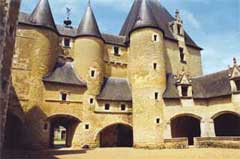Camail Armor Period
The Camail was the distinctive fashion in the knights armor of the late 14th and early 15th century, that is from about 1360 to 1405. As opposed to the coif of mail covering the head, the camail was attached to the helmet. It did not join the hauberk, but hanged over the knight’s surcoat.

Methods of attaching the Camail to helmet
There were two methods to attach it to the knight’s helmet. One method used a flat plate of metal, fitted over the vervelles or staples on the bascinet and kept in place by a lace or a thick wire. The camail was hung from that plate. In the other case, the mail itself was hung over the vervelles and the plate fitted over it and secured in the same way. Looking at the sculpted effigies and brasses, it appears that the second method was more common.
A typical example of the camail period armor is shown here. The arm and leg-pieces completely enclose the limb and are fastened with hinges and straps . The gauntlets are showing the gadlings, or knuckle-knobs, characteristic for this period.
The knight is clad in complete plate, however the hauberk is still present beneath, as may be seen in the armpit area (the "défaut de la cuirasse"), unprotected by plate. In some instances this vital spot was protected by a circular, oval, crescent shaped, or square plate attached by laces, called by some sources the “rondel”, but identified by others to be actually the “moton” or “besague.”
The armor of the Camail period was often richly decorated with engravings, and the effigy of the Black Prince at Canterbury is a good example. An essential part of the camail style of equipment was the light helmet known as the bascinet. A later model of bascinet had a movable visor which, due to its form, is known as the “pig-faced” bascinet . It either had the hinge at the top, or the visor was pivoted at the sides.
Thus, the visored bascinet of the time had three parts: the skull piece, the visor, and the camail proper attached to it using one of the methods described above. While some helmets were of polished metal, others were covered with leather, silk and velvet, the coverings being a matter of taste and fashion. Froissart calls the visor "carnet" and "visiere".
Sometimes, in the case of Royalty or princes of rank, the bascinet was encircled with a fillet or crown of gold and gems.

Camail attached at the back
Some sources considered it to have been devised to take the pressure of the great helm from the head, as often the helm was worn over the lighter bascinet.
However, from the usual position of the orle, and because it is invariably shown highly decorated and jewelled, this explanation cannot stand. The padding worn this way would not be of much help in keeping off the pressure of the helm, and the jewelled decoration would be destroyed.
A French manuscript of the early 15th century is showing how the camail was kept from 'riding ' over the shoulders by attaching it at the back. A little wooden statuette of St. George of Dijon, represented wearing the amor of the period, is showing that, in addition, the camail was fastened to the breast with aiguillettes.


